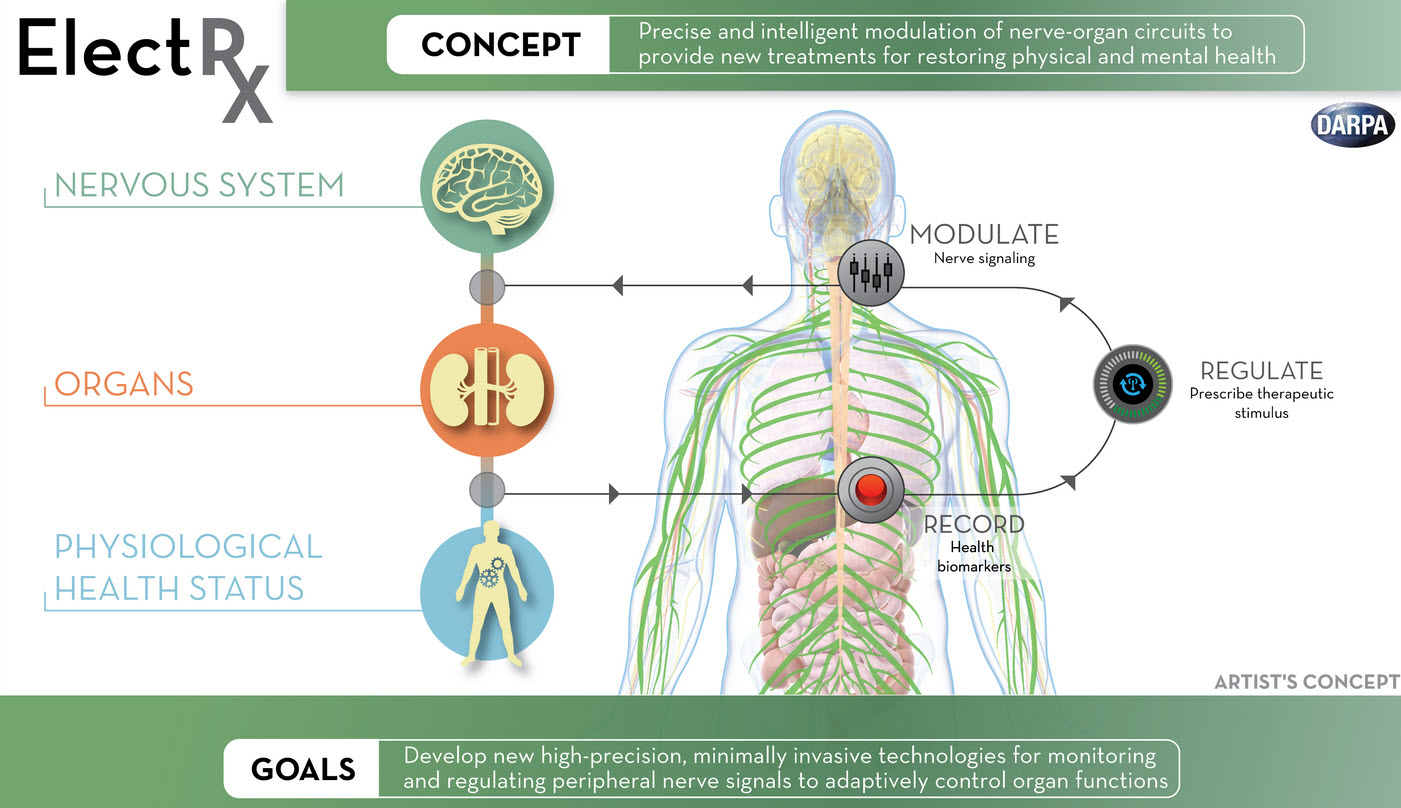DARPA explores neuromodulation of organ functions to help the human body heal itself
September 2, 2014

DARPA ElectRx (credit: DARPA)
DARPA’s new Electrical Prescriptions (ElectRx) (pronounced “electrics”) program aims to develop new high-precision, minimally invasive technologies for modulating nerve circuits to restore and maintain human health, initiated in support of the President’s brain initiative.
“The technology DARPA plans to develop through the ElectRx program could fundamentally change the manner in which doctors diagnose, monitor and treat injury and illness,” said Doug Weber, DARPA program manager. “Instead of relying only on medication, we envision a closed-loop system that would work in concept like a tiny, intelligent pacemaker. It would continually assess conditions and provide stimulus patterns tailored to help maintain healthy organ function, helping patients get healthy and stay healthy using their body’s own systems.”
ElectRx technologies are also expected to help accelerate scientific research aimed at achieving a more complete understanding of the structure and function of specific neural circuits and their role in health and disease.
Potential targets include recently identified circuits involved in regulating immune system function. This could providing new hope for treating a range of inflammatory diseases, including rheumatoid arthritis, systemic inflammatory response syndrome, and inflammatory bowel disease. ElectRx is also expected to improve peripheral nerve stimulation treatments for brain and mental health disorders, such as epilepsy, traumatic brain injury (TBI), Post-Traumatic Stress Disorder (PTSD) and depression.
Targeted ultraminiaturized devices
DARPA notes that this program would require new technologies for in vivo sensing and neural stimulation, such as advanced biosensors and novel optical, acoustic and electromagnetic devices to achieve precise targeting of bundles of nerve fibers that control specific organ functions.
Simple implantable devices for management of chronic inflammatory diseases and other disorders are already in clinical use, and the market for neuromodulation devices is growing rapidly. Current devices, however, are relatively large (about the size of a deck of cards), require invasive surgical implantation, and often produce side effects due to their lack of precision.
ElectRx seeks to create ultraminiaturized devices, approximately the same size as individual nerve fibers, which would require only minimally invasive insertion procedures such as injectable delivery through a needle instead of surgery.
ElectRx is part of a broader portfolio of programs within DARPA that support President Obama’s brain initiative. These include ongoing efforts designed to advance fundamental understanding of the brain’s dynamics to drive applications (Revolutionizing Prosthetics, Restorative Encoding Memory Integration Neural Device, Reorganization and Plasticity to Accelerate Injury Recovery, Enabling Stress Resistance), manufacture robust sensing systems for neurotechnology applications (Reliable Neutral Interface Technology) and analyze large data sets (Detection and Computational Analysis of Psychological Signals).
DARPA expects to release a Broad Agency Announcement with full technical details on ElectRx in the coming months on the Federal Business Opportunities website (www.fbo.gov). Eventual performers would be required to obtain regulatory guidance from the U.S. Food and Drug Administration throughout all phases of the planned five-year program, culminating in approval of an FDA Investigational Device Exemption to enable pilot studies of ElectRx devices in humans. For more information: l[email protected].